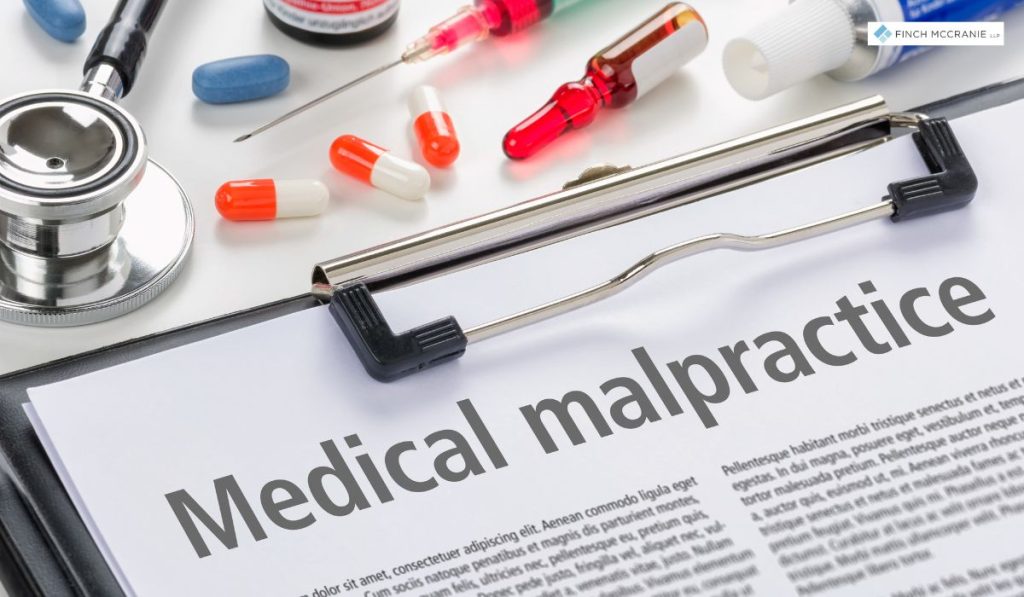Medical malpractice is a complex and sensitive issue that involves the negligence or failure of healthcare professionals to provide a standard level of care, resulting in harm or injury to the patient.
This article aims to shed light on the definition, damages, and examples of medical malpractice, outlining the key aspects that patients and healthcare providers should be aware of.
Definition of Medical Malpractice:
Medical malpractice occurs when a healthcare professional, such as a doctor, nurse, or other medical personnel, deviates from the accepted standard of care, leading to harm or injury to the patient.
The standard of care is the level of skill, care, and diligence that a reasonable healthcare professional in the same field would provide under similar circumstances.
When a breach of this standard occurs, and it directly causes harm, medical malpractice may be established.
Key Elements of Medical Malpractice:
To establish a medical malpractice case, several key elements must be present:
Duty: The healthcare professional must owe a duty of care to the patient, establishing a doctor-patient relationship.
Breach of Duty: The healthcare professional must breach the standard of care, deviating from what a reasonable professional would do in similar circumstances.
Causation: The breach of duty must be the direct cause of the patient’s harm or injury.
Damages: The patient must suffer measurable damages, such as physical or emotional harm, as a result of the medical professional’s negligence.
Damages in Medical Malpractice Cases:
Damages in medical malpractice cases can be categorized into economic and non-economic damages:

Economic Damages: These are tangible and measurable losses, including medical expenses, lost wages, and future medical costs.
Economic damages aim to compensate the victim for the financial impact of the malpractice.
Non-economic Damages: Non-economic damages are intangible losses that are more challenging to quantify, such as pain and suffering, emotional distress, and loss of enjoyment of life.
These damages seek to compensate the victim for the subjective and non-monetary aspects of their suffering.
Examples of Medical Malpractice:
Misdiagnosis or Delayed Diagnosis:
Failure to diagnose a medical condition promptly.
Misdiagnosing a condition, leading to unnecessary treatments or surgeries.
Surgical Errors:
Operating on the wrong body part.
Leaving surgical instruments or sponges inside the patient’s body.
Medication Errors:
Administering the wrong medication or dosage.
Failure to consider a patient’s allergies or potential drug interactions.
Birth Injuries:
Injuries to the newborn during childbirth due to medical negligence.
Failure to respond appropriately to complications during delivery.
Anesthesia Errors:
Administering too much or too little anesthesia.
Failure to monitor the patient’s vital signs during surgery.
Lack of Informed Consent:
Failure to adequately inform the patient of the risks and potential complications associated with a medical procedure.
Legal Process in Medical Malpractice Cases:
Consultation with an Attorney: The first step for a potential medical malpractice victim is to consult with an experienced attorney specializing in medical malpractice cases.
Investigation: The attorney will investigate the case, reviewing medical records, consulting with expert witnesses, and determining if the healthcare professional deviated from the standard of care.
Filing a Lawsuit: If the attorney believes there is a valid case, a lawsuit will be filed against the negligent healthcare provider.
Discovery: Both parties exchange information and evidence through the discovery process, which may include depositions and document requests.
Settlement or Trial: Many medical malpractice cases are settled out of court, but if a fair settlement cannot be reached, the case proceeds to trial.
Verdict and Compensation: If the court finds in favor of the plaintiff, a verdict will be rendered, and compensation will be awarded based on the damages suffered.
The Impact of Medical Malpractice on Patients and Healthcare Providers:
Medical malpractice has profound consequences for both patients and healthcare providers. For patients, the physical, emotional, and financial toll can be devastating.
The trust placed in medical professionals is shattered when negligence occurs, leading to a breach of the standard of care.
Patients may endure prolonged suffering, additional medical expenses, and a diminished quality of life.
On the other hand, healthcare providers facing malpractice claims may experience reputational damage, emotional distress, and increased scrutiny from regulatory bodies.
While the majority of healthcare professionals are dedicated to providing optimal care, instances of malpractice can tarnish the reputation of the entire healthcare system.
Moreover, the fear of litigation may lead to defensive medicine practices, where doctors order unnecessary tests or procedures to avoid potential legal repercussions.
Preventing Medical Malpractice:
Preventing medical malpractice requires a concerted effort from healthcare professionals, institutions, and regulatory bodies.
Some key strategies include:
Continuous Education and Training: Healthcare professionals should engage in ongoing education and training to stay abreast of advancements in medical practices, technologies, and protocols. This ensures that they can provide the highest standard of care to their patients.
Effective Communication: Clear and open communication between healthcare providers and patients is essential.
Ensuring that patients fully understand their diagnosis, treatment options, and potential risks helps in obtaining informed consent and reduces the likelihood of misunderstandings.
Implementation of Best Practices: Healthcare institutions should prioritize the implementation of evidence-based best practices to minimize the risk of errors. Standardized protocols and procedures can help create a safer healthcare environment.
Robust Documentation: Thorough and accurate documentation of patient care is crucial.
Clear medical records not only facilitate better patient care but also serve as valuable evidence in case of a malpractice claim.
Peer Review and Quality Assurance Programs: Regular peer reviews and quality assurance programs within healthcare institutions can identify areas for improvement and address potential issues before they result in harm to patients.
Transparent Reporting: Encouraging a culture of transparency and reporting of adverse events is vital.
Healthcare providers should feel comfortable reporting errors without fear of retribution, allowing for a thorough investigation and the implementation of corrective measures.
Legal Reforms and Policy Considerations:
The legal landscape surrounding medical malpractice is complex and varies by jurisdiction.
Some advocates for reform argue that the current system contributes to defensive medicine practices and escalating healthcare costs. Reforms may include:
Caps on Damages: Some jurisdictions have implemented caps on non-economic damages to prevent excessively high payouts in malpractice cases.
Advocates argue that this helps stabilize malpractice insurance costs and discourages frivolous lawsuits.

Alternative Dispute Resolution: Encouraging alternative dispute resolution methods, such as mediation or arbitration, can provide a quicker and less adversarial means of resolving malpractice claims.
Expert Witness Standards: Establishing clear standards for expert witnesses in malpractice cases can help ensure that the testimony provided is reliable and based on sound medical principles.
Statute of Limitations: Modifying the statute of limitations for filing malpractice claims may be considered, striking a balance between providing patients with adequate time to discover injuries and preventing stale claims.
Conclusion
In conclusion, while medical malpractice cases highlight instances of negligence, they also underscore the importance of continuous improvement within the healthcare system.
By learning from past mistakes, implementing preventive measures, and advocating for thoughtful legal reforms, the goal is to create a healthcare environment where patient safety is paramount, and trust between healthcare providers and patients can be rebuilt and maintained.
If you or someone you know has been a victim of medical malpractice and needs legal assistance, please contact us at Finch McCranie Law Firm.
Our experienced attorneys are here to help you navigate through the complexities of medical malpractice cases and seek the justice you deserve.
FAQs
What are economic and non-economic damages in medical malpractice cases?
Economic damages include measurable losses like medical expenses and lost wages. Non-economic damages involve intangible losses such as pain and suffering, emotional distress, and loss of enjoyment of life.
Can you provide examples of medical malpractice?
Examples include misdiagnosis, surgical errors (like operating on the wrong body part), medication errors, birth injuries, anesthesia errors, and lack of informed consent.
What is the legal process in medical malpractice cases?
The process involves consultation with an attorney, investigation, filing a lawsuit, discovery (evidence exchange), settlement or trial, and, if applicable, a verdict and compensation.
What impact does medical malpractice have on patients and healthcare providers?
Patients may face physical, emotional, and financial tolls. Healthcare providers may experience reputational damage, emotional distress, and increased scrutiny. The fear of litigation may lead to defensive medicine practices.
How can medical malpractice be prevented?
Prevention involves continuous education, effective communication, best practice implementation, robust documentation, peer reviews, quality assurance programs, and transparent reporting of adverse events.
Are there legal reforms for medical malpractice?
Legal reforms may include caps on damages, alternative dispute resolution methods, expert witness standards, and modifications to the statute of limitations to balance patient rights and prevent stale claims.
Why is continuous education important in preventing medical malpractice?
Continuous education helps healthcare professionals stay updated on advancements in medical practices, technologies, and protocols, ensuring they can provide the highest standard of care to patients.
How does transparent reporting contribute to preventing medical malpractice?
Encouraging a culture of transparency and reporting allows healthcare providers to report errors without fear of retribution, facilitating thorough investigations and the implementation of corrective measures.
What is defensive medicine, and how does it relate to medical malpractice?
Defensive medicine involves healthcare providers ordering unnecessary tests or procedures to avoid potential legal repercussions. The fear of litigation in the medical field may lead to defensive practices, impacting patient care and contributing to escalating healthcare costs.
 Trial Attorney Blog
Trial Attorney Blog

